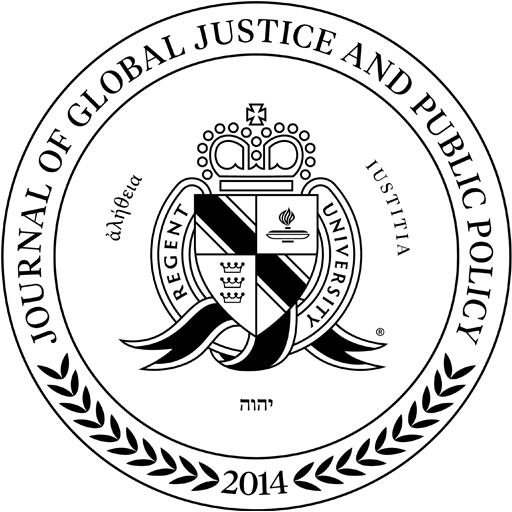Jennifer Baumgardner* | 1 Regent J. Glob. Just. & Pub. Pol. 267 (2015)
INTRODUCTION
An excellent wife, who can find? For her worth is far above jewels. The heart of her husband trusts in her, And he will have no lack of gain . . . . Strength and dignity are her clothing, And she smiles at the future. She opens her mouth in wisdom, And the teaching of kindness is on her tongue.[1]
The words of King Lemuel’s wise mother have been preserved and passed on to generations of young women, preparing them for the challenging, yet honorable duties of marriage and motherhood. In some cultures, however, the focus of a woman’s preparation for marriage is not a preparation of the heart or mind; rather, the standards set for a woman to be an acceptable bride have digressed to physical alterations of her body.[2] Female circumcision is considered a requirement for presenting one’s daughter as a pure and accepted woman in many societies.[3]
Female circumcision or female genital mutilation/cutting (FGM) is a cultural tradition in Indonesia.[4] Although it was outlawed in 2006, the ban did not diminish the practice of FGM in Indonesia.[5] Rather, it became a prevalent practice outside of hospitals, performed by traditional healers in unsanitary conditions.[6] Indonesia represents a unique situation; although it is a secular democratic republic, it is largely Islamic and heavily influenced by ultra-conservative Islamic leaders.[7] Influential Islamic leaders in Indonesia spoke out against the 2006 ban, arguing that male and female circumcision is essential to Islam.[8] In response to this pressure, Indonesia’s Ministry of Health issued regulation 1636/2010, which legalized FGM and included “guidelines” for how FGM should be performed.[9]
Although the United Nations passed Resolution 67/146 in December 2012, specifically condemning FGM in any capacity, the Indonesian government has continued to allow medicalized FGM.[10] The Council of Indonesian Ulama (MUI)[11] demanded that the Indonesian government maintain the legality of female circumcision.[12] Although many international Islamic leaders condemn FGM, the highly influential religious leaders in Indonesia maintain that “[c]ircumcision is a part of the Islamic teachings that were recommended for Muslims, both male and female.”[13]
Many organizations have helped to decrease the prevalence of FGM in various African nations, and similar steps must be taken in Indonesia to fight the prevalence of FGM.[14] These organizations have been successful by focusing not only on legislation and government policy, but also on educating those practicing FGM and reaching out to communities.[15] In addition to this multi-level approach, international pressure must be placed on Indonesia to end this practice. Professor Terry Hull of the Australian Demographic & Social Research Institute, Australian National University,[16] asserts that female circumcision is, alarmingly, becoming more popular and brutal in Indonesia.[17]
Indonesia faces particular difficulty in eradicating FGM as it navigates opposing pressures from the international community and the MUI. The Indonesian government must take a firm stance against and work more effectively to eradicate FGM in order to fulfill its obligations and commitments to the United Nations Human Rights Committee and the international community. Due to Indonesia’s unique political and religious composition, the Indonesian government must integrate community education and social programs that inform Indonesians on the dangers of FGM and the truth about its origins in addition to criminalizing all FGM procedures. This Note will focus on the often- overlooked practice of FGM in Indonesia, including the origins of the practice, the medicalization of FGM in Indonesia, why it maintains such a strong foothold in that nation, and the efforts that should be taken to eradicate FGM.
FEMALE CIRCUMCISION AND FEMALE GENITAL MUTILATION/CUTTING
FGM currently affects approximately 140 million girls and women internationally, and about 3 million women are at risk of undergoing FGM each year.[18] FGM is largely the product of religious sects, tradition, and culture.[19] As a result of these deeply ingrained conventions, various types of FGM are practiced in different communities and nations worldwide.[20]
A. Types of FGM
FGM is classified into four categories: Type I includes the most harmful and severe types of FGM, whereas Type IV generally includes less-severe types of FGM.[21] Type I includes partial or complete removal of a woman’s clitoris or prepuce, also called a “clitoridectomy.”[22] Type II is the partial or complete removal of the clitoris and labia minora, which sometimes includes excision of the labia majora.[23] Type III includes the narrowing of the vaginal orifice with a covering seal, which is created by cutting and appositioning the labia minora or the labia majora.[24] This type is sometimes accompanied by excision of the clitoris.[25] Type IV encompasses all other harmful FGM for non-medical purposes, including pricking, piercing, incising, scraping, and cauterization.[26]
There are severe short-term and long-term consequences of FGM, the results of which may vary depending on what type of FGM is performed.[27] Short-term consequences may “include severe pain, shock caused by pain and/or excessive bleeding (hemorrhage), difficulty in passing urine and faeces” due to swelling, fluid retention, and infection.[28] Hemorrhaging and infection have led to death in some cases.[29] Long-term consequences of FGM are both physical and psychological.[30] Physically, women may experience dermoid cysts, abscesses, severe pain during sexual intercourse, chronic pelvic infections that can lead to chronic back and pelvic pain, urinary tract infections, menstruation problems, and even infertility in some cases.[31] Additionally, there is an increased risk for childbirth complications, including postpartum hemorrhaging, necessary caesarean sections, and increased probability of tearing.[32] Studies have found higher death rates among infants whose mothers had been subjected to FGM.[33]
- Proverbs 31:10–11, 25–26 (NASB). ↩︎
- Female Genital Mutilation, WORLD HEALTH ORG. 13 (2000), available at http://whqlibdoc.who.int/hq/2000/who_fch_wmh_00.5_eng.pdf. ↩︎
- Id. ↩︎
- Meiwita Budiharsana et al., Female Circumcision in Indonesia: Extent, Implications and Possible Interventions to Uphold Women’s Health Rights, POPULATION COUNCIL 8 (Sept. 2003), available at http://pdf.usaid.gov/pdf_docs/PNACU138.pdf. ↩︎
- Irfan Al-Alawi, Indonesian Government’s Backward Step on Female Genital Mutilation, GATESTONE INST. (Sept. 26, 2011, 4:30 AM), http://www.gatestoneinstitute.org/2452/indonesia-female-genital-mutilation. ↩︎
- Lack of regulation and oversight contribute to the persistent practice of FGM in Indonesia. Indonesia: Female Genital Mutilation Persists Despite Ban, IRIN (Sept. 2, 2010), http://www.irinnews.org/report/90366/indonesia-female-genital-mutilation-persists-despiteban. ↩︎
- Islam in Indonesia, INDONESIA-INVS., http://www.indonesiainvestments.com/culture/religion/islam/ (last visited Apr. 6, 2015). ↩︎
- Al-Alawi, supra note 5. “Nadhlatul Ulama (NU, also spelled Nadhatul Ulama, and meaning ‘Revival of Islamic Scholars’) issued a religious opinion in 2010 approving FGM but advising against ‘cutting
too much.’” Id. ↩︎ - Abby Selden, Female Genital Mutilation in Indonesia, HOW SHE SCREAMS: A SAMA TATA FOUND. BLOG (Mar. 30, 2012), http://samatatafoundationfgm.wordpress.com/2012/03/30/female-genital-mutilationin-indonesia/. ↩︎
- G.A. Res. 67/146, ¶ 4, U.N. DOC. A/RES/67/146 (Dec. 20, 2012); Al-Alawi, supra note 5. ↩︎
- The Council of Indonesian Ulama, also known as the Majelis Ulama Indonesia (MUI), is Indonesia’s top Muslim clerical body. Council of Indonesian Ulama, BERKLEY CENTER. FOR RELIG. PEACE & WORLD AFF., http://berkleycenter.georgetown.edu/organizations/council-of-indonesianulama
(last visited Jan. 28, 2015). It is a national moderate Muslim clerical body that issues “fatwas” or religious rulings, for various contemporary issues and public policies. Id. ↩︎ - MUI Pushes Govt to Circumcise Girls, JAKARTA POST (Jan. 22, 2013, 9:41 AM), http://www.thejakartapost.com/news/ 2013/01/22/mui-pushes-govt-circumcise-girls.html. ↩︎
- Id. ↩︎
- See, e.g., Prevalence and Legal Framework, DESERT FLOWER FOUND., http://www.desertflowerfoundation.org//wp-content/uploads/2014/07/Chart-FGM-Legal-Framework_english.pdf (last visited Mar. 29, 2015). ↩︎
- See generally MUTESHI J. & SASS J., FEMALE GENITAL MUTILATION IN AFRICA: AN ANALYSIS OF CURRENT ABANDONMENT APPROACHES (Dec. 2005), available at http://www.path.org/publications/files/CP_fgm_combnd_rpt.pdf. ↩︎
- Professor Terence H Hull, AUSTRALIAN NAT’L UNIV., https://researchers.anu.edu.au/researchers/hull-th (last update Apr. 7, 2015). ↩︎
- Debate in Indonesia Over UN Plan to Ban Female Circumcision, ABC RADIO AUSTRALIA (Jan. 23, 2013, 10:07 PM), http://www.radioaustralia.net.au/international/radio/program/asia-pacific/debate-in-indonesia-over-un-plan-to-ban-female-circumcision/1077806. ↩︎
- Letter from Yasmeen Hassan, Global Dir., Equality Now and Listyowati, Chairperson, Kalyanamitra, to U.N. Human Rights Committee 1 (June 13, 2013), available at http://www2.ohchr.org/english/bodies/hrc/docs/ngos/EqualityNow1_Indonesia_HRC108.pdf; Press Release, United Nations, UN Agencies Unite Against Female Genital Mutilation (Feb. 27, 2008), available at https://www.un.org/es/women/endviolence/pdf/FGM%20press%20release.pdf. ↩︎
- See Budiharsana, supra note 4, at 8–9. ↩︎
- See Sexual and Reproductive Health: Female Genital Mutilation and Other Harmful Practices, WORLD HEALTH ORG., http://www.who.int/reproductivehealth/topics/fgm/prevalence/en/ (last visited Mar. 29, 2015). ↩︎
- Media Centre: Female Genital Mutilation: Factsheet No. 241, WORLD HEALTH ORG. (Feb. 2014),
http://www.who.int/mediacentre/factsheets/fs241/en/; see also An Update on WHO’s Work on Female Genital Mutilation (FGM) Progress Report, WORLD HEALTH ORG. 3 (2011), available at http://whqlibdoc.who.int/hq/2011/WHO_RHR_11.18_eng.pdf [hereinafter WHO Progress Report]. ↩︎ - WHO Progress Report, supra note 21. ↩︎
- Id. ↩︎
- Id. ↩︎
- Id. ↩︎
- Id. ↩︎
- See id. at 2–3. ↩︎
- Id. at 2. ↩︎
- Id. at 2–3. ↩︎
- See id. at 3. ↩︎
- Id. ↩︎
- Id. ↩︎
- Id. ↩︎
* J.D. 2015, Regent University School of Law.

